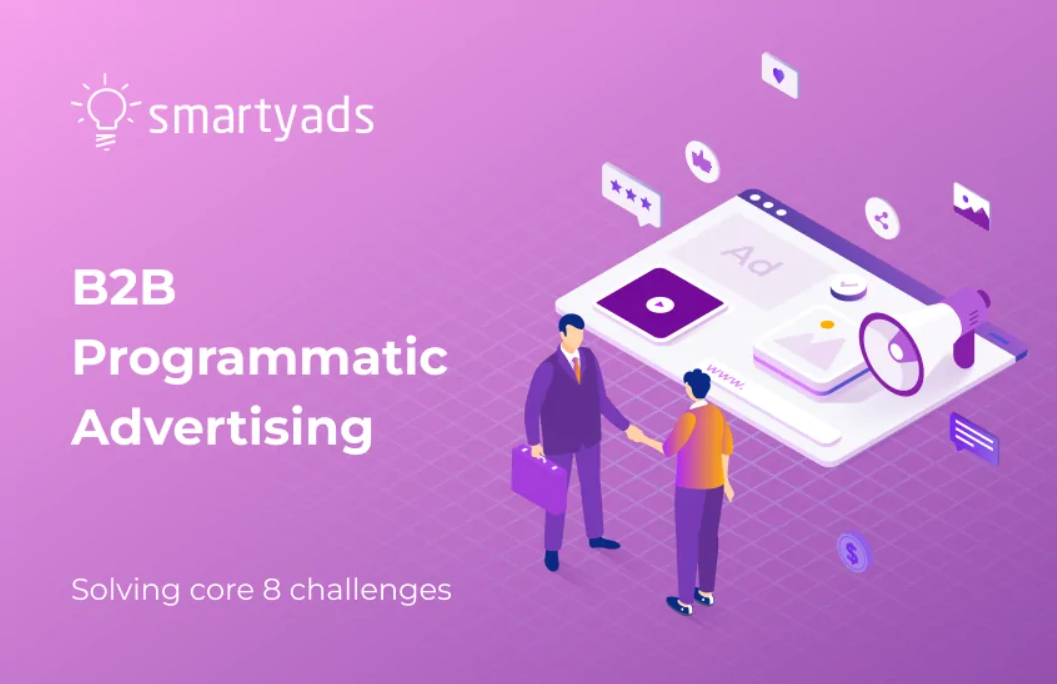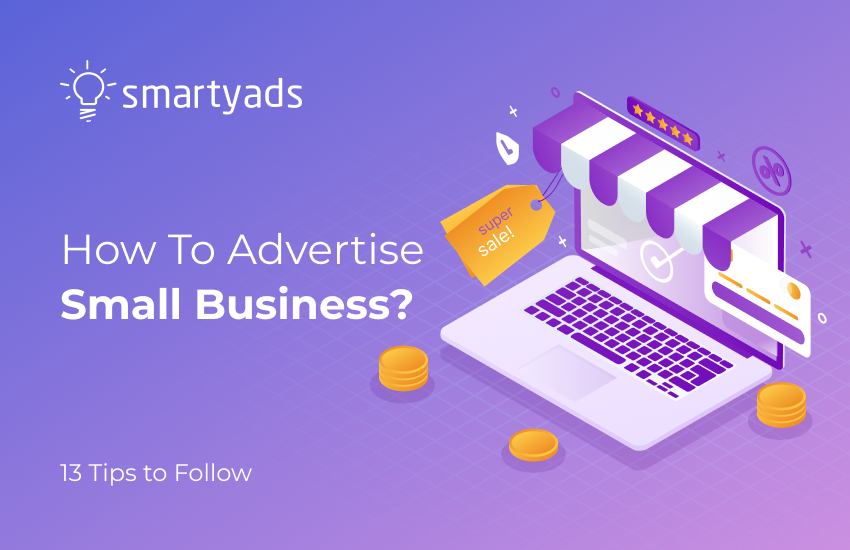Over 40% of businesses fell short of their sales targets last year (2022). And it's happening not because they lack sales skills; it's a result of the increasingly complex nature of sales. B2B businesses often need more qualified leads, which appears to be a struggle for B2B marketers.
The digital advertising landscape is marked by longer sales cycles and intensified competition for B2B marketers. Gaining brand awareness from online advertising and a shortage of first-party data pose additional challenges. B2B programmatic advertising, which is mostly based on real-time bidding, is here to help B2B businesses find their ideal target audience as it is based on a data-driven approach.
So, can programmatic advertising be really helpful here? This piece of content will explore common struggles of B2B businesses and suggest ways to avoid or overcome them with programmatic ads. Challenges of B2B companies should not be viewed as roadblocks but rather as opportunities to reassess your advertising tactics with a smarter approach. So, let's get started.
B2B marketing system depends on 7 core factors
Let's start with a definition of B2B (business-to-business). It refers to a type of business where one company sells products or services to another company (not a customer — B2C).
B2B transactions are typically more complex than B2C (business-to-consumer) transactions because they often involve larger volumes of products or services, longer sales cycles, and more stakeholders.
Here are some specifics of B2B business:
- Target audience. The primary target audience for B2B businesses is other businesses rather than individual consumers. A B2B marketer may segment target account lists, each requiring a different ad approach. Some companies create a target account strategy meaning that their sales organization has a list of accounts that appear as suitable buyers (account-based advertising);
- Sales funnel/marketing funnel. B2B sales often involve a longer, more complex process than B2C sales. The sales process can include multiple decision-makers (stakeholders);
- Relationship building. B2B businesses often focus on building long-term customer relationships rather than making one-time sales. This involves providing ongoing support, excellent customer service, and personalized solutions to meet their customers' needs;
- Marketing strategy. B2B businesses typically use highly targeted advertisements focusing on lead generation and lead nurturing. B2B marketers may use strategies such as content marketing, email marketing, account-based marketing, programmatic advertising, and contextual targeting to reach their target audience;
- Pricing. B2B pricing is often negotiated on a case-by-case basis, developed on factors such as the volume of the order, payment terms, and ongoing support and services. Plus, in B2B, the product is more complex, which entails a higher price and, thus, a longer decision-making cycle;
- Products and services. B2B businesses often offer products and services that are specific to the needs of other companies, such as enterprise software, industrial equipment, and professional services;
- Sales channels. B2B businesses may sell their products or services through various channels, including direct sales, distributors, and resellers.
Overall, B2B businesses require a unique approach to sales, marketing, and digital advertising to be successful in their niche. Just to compare — in a B2C niche, the customer may see the product in the ad (let's say, a mouse pad) and immediately decide to purchase it at the store.
In the B2B niche, the product is sold to the company, and the overall cost (let's say a software platform) is typically much higher than the cost of a B2C product (a mouse pad).
Even if a single person makes the decision (not many stakeholders), the sales cycle from discovering a product to purchasing may take at least several months.
If we take, for instance, software platforms and marketing systems, many of them provide free trial periods that can last up to several months. This way, the decision-making period can be greatly extended for B2B sales.
Why is programmatic advertising a must-have for B2B marketers?
Companies often use B2B programmatic advertising for serving ads because it is a huge resource saver. Machine learning and artificial intelligence at the core of the platforms make it easy for marketers to maintain an ongoing optimization of ad dollars invested in the campaigns.
Programmatic advertising is the most important tool used for branding campaigns to drive brand awareness KPI. Since the decision-making cycle is long, it is important to form overall awareness of the product before expecting a purchase. This is why programmatic advertising based on impressions (CPM) is so important for B2B sales.
B2C companies, meanwhile, can also greatly benefit from click-based campaigns as there is a higher likelihood that the customer will convert right after seeing the ad (especially when the product is simple, understandable, and cheap).
More so, a brand awareness campaign based on CPM is normally more affordable than performance campaigns, where the ads generate a payment from clicks or conversions.
How programmatic advertising works
Programmatic marketing is hugely based on automation and optimization. In a nutshell, a programmatic ecosystem consists of a DSP, ad exchange, SSP, and DMP (optionally).
Elements of the programmatic ecosystem:
- DSP — a demand-side platform designed to automate ad inventory buying for advertisers;
- SSP — a supply-side platform designed to automate ad space selling for publishers;
- Ad exchange — an open marketplace for both (also supports real-time bidding auctions). Ad exchanges can work for ad space accumulation, buying, and selling. There are also ad networks that function similarly to ad exchanges (read about their differences);
- DMP — a data management platform that provides an additional source of data suitable for targeting (and is often integrated with DSP for more refined and precise targeting).
Let's try to simplify it as much as possible; here's how ad inventory is bought and sold in this ecosystem.
How does it all work together?
A user opens the web page, and while this is happening, their data in cookies is getting passed to the SSP (in case the publisher works with SSP). The SSP forms a request about available ad space (it contains ad space characteristics and user information).
The ad exchange initiates the real-time bidding auction where programmatic ad buying is happening.
Before participating in the auction, advertisers set up their campaign requirements on programmatic DSP (demand-side platform). Through one platform, advertisers can access multiple ad exchanges and DSPs connected to the network of platforms (connected through RTB).
Advertisers and publishers can also join ad exchanges directly to participate in media trading. However, SSPs and DSPs normally have more diverse functionality specifically developed for buyers and sellers, while ad exchanges function as open marketplaces available for everyone.
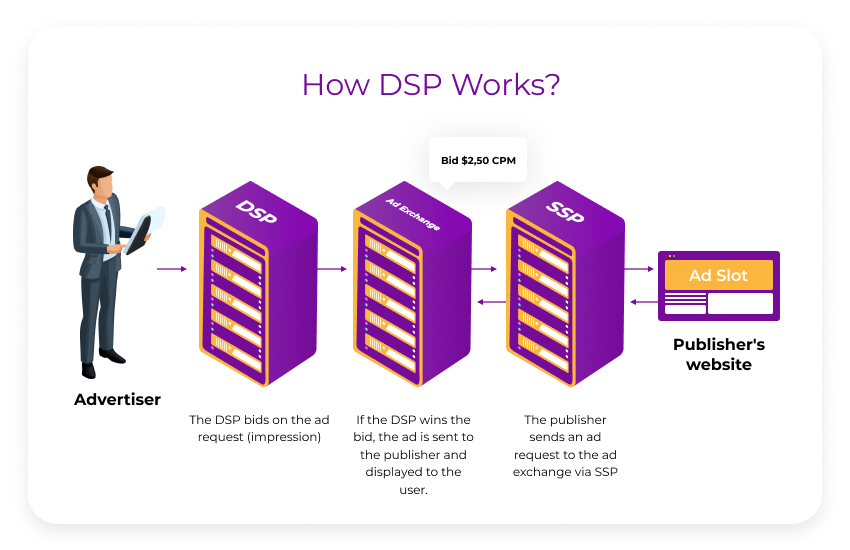
While setting up programmatic campaigns, advertisers select who they will be serving ads to (targeting characteristics of the demographics — age, location, country, OS, gadget types, etc.). As well, on demand-side platforms, advertisers regulate their budget — how it will be distributed throughout the campaign (to optimize ad spend).
This way, DSP already knows what impressions to bid on before tapping into the RTB auction that is taking place on an ad exchange. First, a DSP receives requests from SSP and analyzes its data; in simple words, could this ad be relevant to this user? Does this user fall within the target audience for the advertiser?
If DSP qualifies this user as valuable, DSP takes part in the auction and makes a bid along with other DSPs. The ad exchange defines the winner (the highest bid), and then the digital ad space inventory is filled with the winner's ad. This is how programmatic algorithms organize ad delivery.
B2B programmatic: from challenge to solution
Now that we revealed the main challenges of B2B businesses, it's time to review how exactly programmatic advertising can address them.
Challenge 1 — Targeting only businesses
The struggle of marketers in B2B, as we already found out, is that they need to serve highly relevant advertisements to the right audiences. They need to target ads only to those users who make decisions in the company, for example, the CEO and CTO.
Channeling digital advertisements to the wrong audience, which doesn't make a decision, would mean that ad spend goes to waste (since advertisers pay for these irrelevant impressions too).
Solution: targeting only the right audience
Programmatic targeting allows advertisers to place highly relevant advertisements thanks to the varied options suitable for targeting (age, geo, language, device type, carrier, OS), and so on.
Aside from this, with programmatic, marketers can place ads on paid media according to the time of the day (dayparting) and adjust impressions correctly according to the time zones.
Challenge 2 — Organizing omnichannel advertising
As we've already found out, B2B company may distribute their products via a variety of channels. In advertising, the B2B company should also aim to distribute its ad message across different channels to reach better visibility and to address audiences whenever they go.
Solution: launching an omnichannel campaign
In one of the surveys, IAB revealed that B2B marketers prefer using the following channels for advertising: paid search Google ads, video ads, rich media, and retargeting. Some brands also launch paid social campaigns.
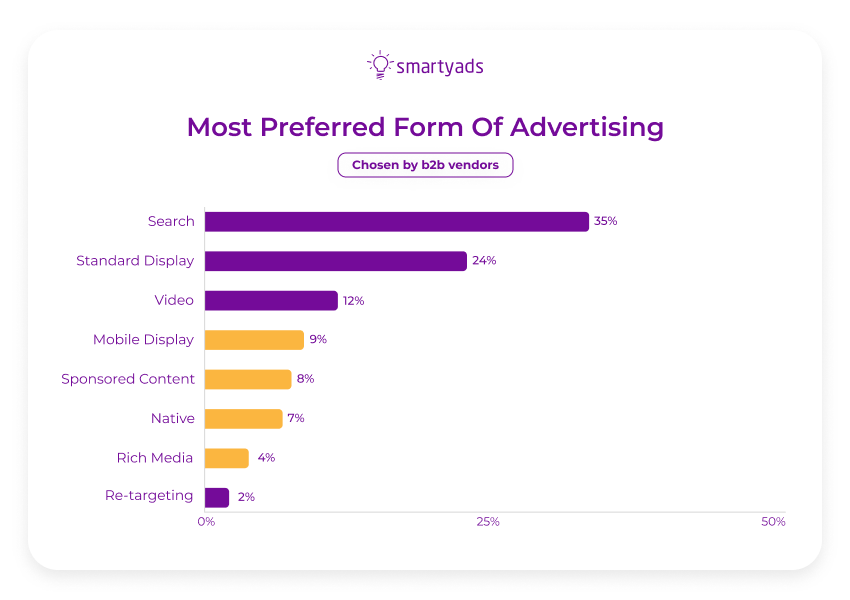
At the same time, your sales team may save a lot of time with the marketing automation that programmatic advertising delivers. On a single programmatic demand side platform, advertisers can serve ads on CTV, mobile, in-app, mobile desktop, audio, and other marketing channels at the same time.
Challenge 3 — Manual workload
Placing the ads on different channels entails manual effort, using different detached ad platforms, and constant campaign management. It all takes time. More so, for every channel, marketers typically need to create suitable ad formats that appear seamlessly on the screen.
Solution: using programmatic automation
B2B programmatic can work wonders when we talk about selling process optimization. Yes, at first, the advertiser needs to configure the campaign properly in order to bid only on suitable impressions. After this, the system will be bidding, constantly learning and analyzing processes in order to optimize costs and other campaign aspects in the future.
A good example is a proprietary feature of SmartyAds DSP adaptive CPM, which learns how to keep the CPM competitive enough to win in the auctions, yet low enough to prevent overspending.
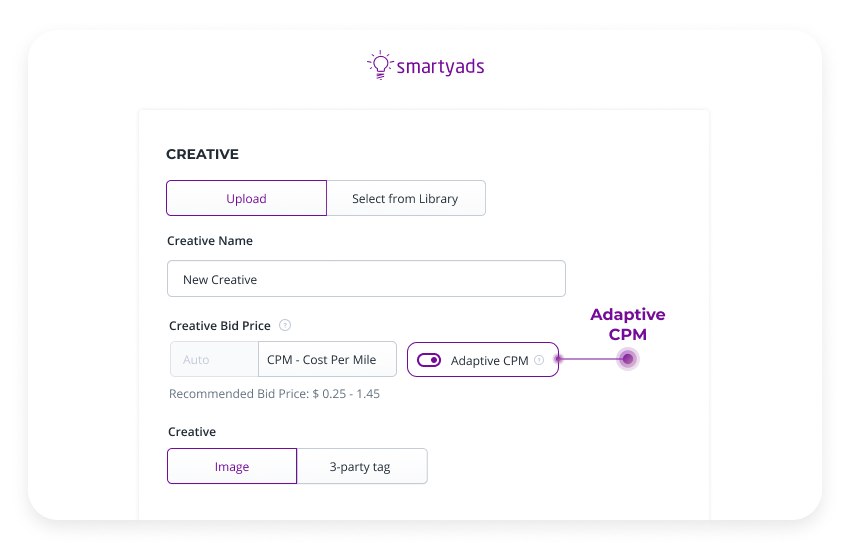
More so, the platform can even solve the problem of adapting the creative sizes to the right resolutions (the creative size adaptation feature on SmartyAds is called Autoresize). This way, there's no need to worry about the quality worsening of the creative that appears on different types of user screens. The sizes will be adjusted automatically to suit each type of device.
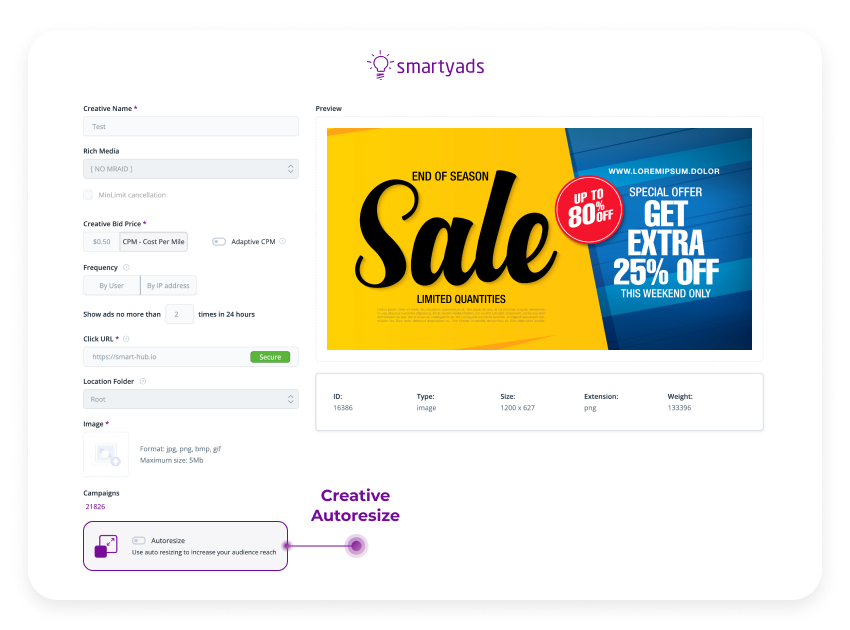
Those are the key benefits of B2B programmatic advertising.
Challenge 4 — Accurate performance measurement
B2B advertisers are spending huge internal resources as they place ads on different fragmented media. Counting their performance appears to be even more difficult as it requires a lot of time and various tools for measurement and attribution.
Solution: measuring performance on a single platform
Programmatic advertising makes it easy for advertisers to measure the performance of their campaigns across different channels and even on per campaign and per-creative basis.
As advertisers buy ad space online, they can measure the number of views, see the win rate over time, and discover how many clicks were achieved after serving programmatic ads.
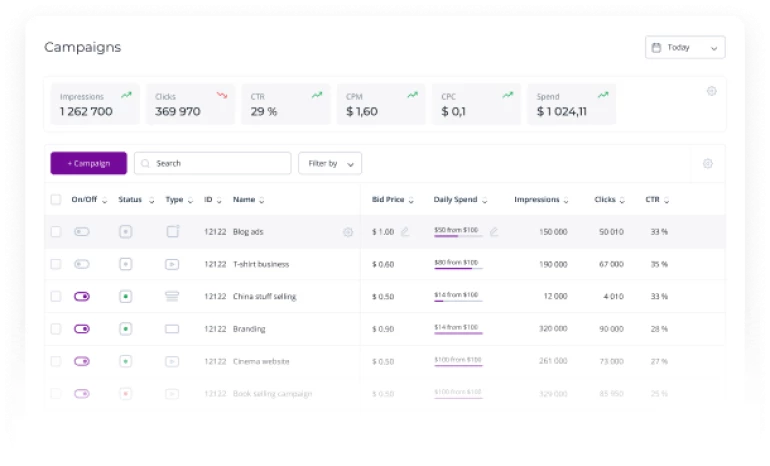
Challenge 5 — Approaching stakeholders and decision-makers
According to Statista, the Covid-19 pandemic has caused 57% of vendors to experience longer sales cycles, primarily due to the involvement of multiple decision-makers in the buying process.
This can result in prolonged periods spent at each stage of the sales funnel, making it challenging to determine when to push or hold back.
Solution: crafting individualized campaigns and programmatic ads
The solution to moving prospects through the funnel is to focus on nurturing them, providing value, responding to their needs, and creating a personalized experience.
Additionally, targeting only the decision-maker can sometimes prolong the decision-making cycle, so it is essential to craft individual advertising campaigns for each segment of decision-makers while leveraging their audience persona.
Programmatic advertising makes it easy for advertisers to manage multiple ad exchanges, as well as multiple channels and ad formats. These ad exchanges communicate with certain SSPs and, thus, publishers. With diverse campaigns directed towards certain audience personas, advertisers can easily reach the right audiences on the right ad inventory.
Challenge 6 — Cutting through the noise
In the modern sales environment, getting heard is the number one task; the market is oversaturated, and for that reason, this is so difficult.
In fact, only 21.5% of sales emails are getting opened, and if you believe reaching out by phone is easier, think again, as it takes an average of eighteen calls to connect with a potential buyer.
Reaching out to prospects is challenging, but capturing their attention, encouraging them to read your message, and prompting a response are even harder.
Solution: using the right targeting options
To combat this, it's essential to leverage the value you offer and utilize it to provide prospects with high-quality programmatic ads and a personalized experience.
Adopt precise targeting methods and steer clear of generic messaging. Most importantly, remember that the goal is to establish genuine and lasting relationships with potential customers.
Challenge 7 — Selecting the best inventory
When hunting for ad inventory, programmatic advertising can be your best friend. Programmatic buying can really offer access to the widest range of inventory. Modern platforms are also thoroughly protected from ad fraud (a frequent concern of advertisers).
Solution: using RTB and programmatic direct
B2B programmatic advertising has a lot of options when it comes to inventory selection. For example, in automated RTB auctions, you can be sure that your ads will be served on different suitable and well-vetted websites across the globe.
If you are searching for exclusive inventory, you can use programmatic direct deals or private marketplace deals. With programmatic direct, advertisers can be more confident regarding where their ads are placed and for what cost. That's the main strength of programmatic advertising — the varied choice.
Challenge 8 — Insufficient data
Just 46% of sales representatives have adequate data insights and lack data to compose comprehensive user profiles.
Solution: using DMP
To maximize the benefits, it is important to align your sales and marketing efforts, determine the information you need to gather and establish an efficient method for storing and updating the data.
Programmatic advertising/programmatic buying is an instrument that will help to make your campaigns data-driven, as data is the main component used for buying and selling ads in programmatic marketing.
Plus, programmatic advertising platforms like DMP allow you to effectively gather and segment the data and use it to make targeting super precise. Find B2B programmatic advertising vendors that provide DMP services and can give you valuable advice on utilising all useful leverages of it.
To sum up
Programmatic advertising/programmatic marketing is a universal tool for B2B marketers as it effectively raises brand awareness — a part without which effective sales in B2B are impossible.
Today we've reviewed 8 common challenges of B2B businesses and discovered how programmatic advertising could address them all.
